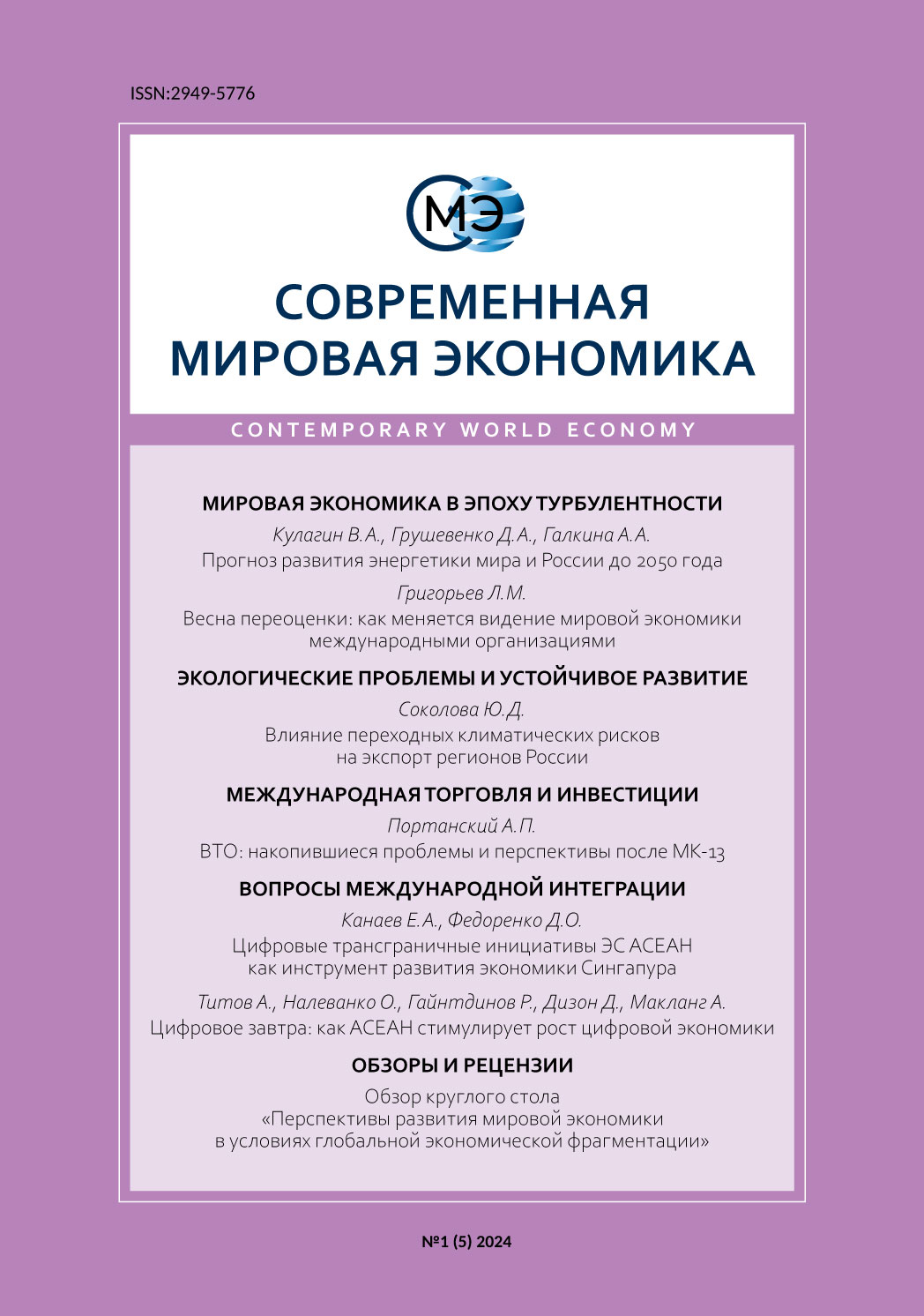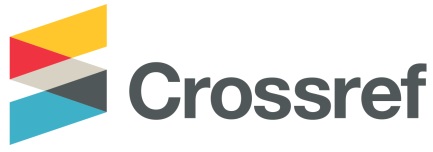Влияние переходных климатических рисков на экспорт регионов России
Аннотация
В условиях исключительного внимания государства к вопросам развития экспорта на первый план выходит изучение детерминант осуществления экспортных операций регионов России. Экспортирующие компании сталкиваются с такими ограничивающими факторами, как технологическая отсталость, несоответствие качества товаров международному спросу, сложность таможенных процедур. В условиях современной климатической повестки выделяется новый тип экономических рисков для экспортеров - переходные климатические риски. Данная группа рисков формируется как результат намерений государств достичь климатических целей, заявленных в рамках Парижского соглашения, и перейти на рельсы низкоуглеродного развития. Переходные риски для экспортеров могут проявляться в виде торговых ограничений, экологических требований к товарам, стремления стран-импортеров заменить более углеродоемкую экспортируемую продукцию. Оценка развития экспорта российских регионов в условиях переходных климатических рисков - нетривиальная задача. Глобальный энергетический переход может генерировать как риски, так и возможности для экспорта России. Целью данного исследования выступает моделирование влияния переходных климатических рисков на динамику объемов экспорта российских регионов на основе данных за период 2013–2021 гг. с применением расширенной гравитационной модели международной торговли. Исследование имеет две отличительные особенности: проводится комплексный анализ, представляющий три типа переходных климатических рисков: распространение углеродного регулирования, развитие альтернативной энергетики и электрификация транспорта. Выявляются региональные факторы, определяющие знак влияния каждого из них на объемы экспорта. Исследование выявило, что влияние переходных климатических рисков на экспортные показатели российских регионов различно. Во-первых, углеродное регулирование торговых партнеров создает риски для многих регионов России, но способствует увеличению экспорта из регионов с наиболее благоприятными социально-экономическими условиями для инновационной деятельности и активной региональной климатической политикой. Во-вторых, производство альтернативных источников энергии в странах-партнерах снижает зависимость от российского импорта энергоносителей, что ставит под угрозу устойчивость экономик регионов, специализирующихся на добыче традиционных энергоресурсов. При этом регионы России, богатые полезными ископаемыми, вносят существенный вклад в глобальные тенденции энергетического перехода как поставщики критически важных минеральных ресурсов и увеличивают свой экспорт.
Скачивания
Литература
Albert, M., 2021. The global politics of the renewable energy transition and the non-substitutability hypothesis: towards a ‘great transformation’? Review of International Political Economy. Vol. 29. Issue 12. Pp. 1–16. https://doi.org/10.1080/09692290.2021.1980418
Andersen, E., Shan, Y., Bruckner, B., Černý, M., Hidiroglu, K., Hubacek, K., 2024. The vulnerability of shifting towards a greener world: the impact of the EU’s green transition on material demand. Sustainable Horizons. Vol. 10. No100087. https://doi.org/10.1016/j.horiz.2023.100087
Arndt, C., 2023. Climate change vs energy security? The conditional support for energy sources among western Europeans. Energy Policy. Vol. 174. No113471. https://doi.org/10.1016/j.enpol.2023.113471
Buhaug, H., Benjaminsen, T., Gilmore, E., Hendrix, C., 2023. Climate-driven risks to peace over the 21st century. Climate Risk Management. Vol. 39. No100471. https://doi.org/10.1016/j.crm.2022.100471
Carattini, S., Heutel, G., Melkadze, G., 2023. Climate policy, financial frictions, and transition risk. Review of Economic Dynamics. Vol. 51. Pp. 778-794. https://doi.org/10.1016/j.red.2023.08.003
Cergibozan, R., 2022. Renewable energy sources as a solution for energy security risk: empirical evidence from OECD countries. Renewable Energy. Vol. 183. Pp. 617–626. https://doi.org/10.1016/j.renene.2021.11.056
Chen, X., He, J., Qiao, L., 2022. Does environmental regulation affect the export competitiveness of Chinese firms? Journal of Environmental Management. Vol. 317. https://doi.org/10.1016/j.jenvman.2022.115199
Chepeliev, M., Hertel, T., Mensbrugghe, D., 2022. Cutting Russia’s fossil fuel exports: short-term economic pain for long-term environmental gain. The World Economy. 2022. Vol. 45. Issue 11. Pp. 3314-3343. https://doi.org/10.1111/twec.13301
Cherepovitsyn, A., Solovyova, V., 2022. Prospects for the development of the Russian rare-earth metal industry in view of the global energy transition-a review. Energies. Vol. 15. https://doi.org/10.3390/en15010387
Cherepovitsyn, A., Solovyova, V., Dmitrieva, D., 2023. New challenges for the sustainable development of the rare-earth metals sector in Russia: transforming industrial policies. Resources Policy. Vol. 81. No103347. https://doi.org/10.1016/j.resourpol.2023.103347
Chupina, D., 2022. Impact of the Green Deal on copper imports from Russia to the EU. Voprosy ekonomiki. No 1. Pp. 110–125. https://doi.org/10.32609/0042-8736-2022-1-110-125 (in Russian).
Correia, S., Guimaraes, P., Zylkin, T., 2019. Fast Poisson estimation with high-dimensional fixed effects. The Stata Journal. Vol. 20. Issue 1. Pp. 95–115. https://doi.org/10.1177/1536867X20909691
Costantini, V., Mazzanti, M., 2021. On the Green and Innovative Side of Trade Competitiveness? The Impact of Environmental Policies and Innovation on EU Exports. Research Policy. Vol. 41. Issue 1. Pp. 132–153. https://doi.org/10.1016/j.respol.2011.08.004
Crowley-Vigneau, A., Kalyuzhnova, Y., Ketenci, N., 2023. What motivates the ‘green’ transition: Russian and European perspectives. Resources Policy. Vol. 81. No103128. https://doi.org/10.1016/j.resourpol.2022.103128
Dunz, N., Naqvi, A., Monasterolo, I., 2021. Climate sentiments, transition risk, and financial stability in a stock-flow consistent model. Journal of Financial Stability. Vol. 54. No100872. https://doi.org/10.1016/j.jfs.2021.100872
Elshkaki, A., Graedel, T., Ciacci, L., Reck, B., 2016. Copper demand, supply, and associated energy use to 2050. Global Environmental Change. Vol. 39. Pp. 305–315. https://doi.org/10.1016/j.gloenvcha.2016.06.006
Fedyunina, A., Simachev, Y., Drapkin, I., 2023. Intensive and Extensive Margins of Export: Determinants of Economic Growth in Russian Regions under Sanctions. Ekonomika regiona / Economy of regions. Vol. 19. No 3. Pp. 884-897. https://doi.org/10.17059/ekon.reg.2023-3-20
Glazatova, M., Daniltsev, A., 2020. Main trends in the development of world trade and structural features of Russian exports. Journal of the New Economic Association. Vol. 45. No 1. P. 183–192. https://www.doi.org/10.31737/2221-2264-2020-45-1-8 (in Russian).
Gong, M., You, Z., Wang, L., Cheng, J., 2020. Environmental regulation, trade comparative advantage, and the manufacturing industry’s green transformation and upgrading. International Journal of Environmental Research and Public Health. Vol. 17. Issue 8. https://doi.org/10.3390/ijerph17082823
Hamaguchi, Y., 2023. Environmental tax evasion as a determinant of the Porter and Pollution Haven Hypotheses in a corrupt political system. Economic Analysis and Policy. Vol. 79. Pp. 610–633. https://doi.org/10.1016/j.eap.2023.06.032
Harpprecht, C., Xicotencatl, B., Nielen, S., Meide, M., Li, C., Li, Z., Tukker, A., Steubing, B., 2024. Future environmental impacts of metals: a systematic review of impact trends, modeling approaches, and challenges. Resources, Conservation and Recycling. Vol. 205. No107572. https://doi.org/10.1016/j.resconrec.2024.107572
Islam, M. M., Tareque, M., Moniruzzaman, M. & Ali, M. I., 2022. Assessment of Export-Led Growth Hypothesis: The Case of Bangladesh, China, India and Myanmar. Ekonomika regiona/Economy of regions, 18(3), 910-925, https://doi.org/10.17059/ekon.reg.2022-3-20
Islam, M., Sohag, K., 2023. Mineral import demand and wind energy deployment in the USA: co-integration and counterfactual analysis approaches. Mineral Economics. https://doi.org/10.1007/s13563-023-00382-2
Islam, M., Sohag, K., Alam, M., 2022. Mineral import demand and clean energy transitions in the top mineral-importing countries. Resources Policy. Vol. 78. No 102893. https://doi.org/10.1016/j.resourpol.2022.102893
Kadochnikov, S., Fedyunina, A., 2013. Economic growth due to export externalities: a spatial econometric analysis for Russian regions, 2003-2008. International Journal of Economic Policy in Emerging Economies. Vol. 6. Issue 4. Pp. 358–374. https://doi.org/10.1504/ijepee.2013.057909
Kutyrev, G., Kolomina (Apasova), A., Lebedev, M., 2021. Environmental protectionism as a factor in the transformation of the industrial and foreign trade structure on the example of Russia and GermanyRussia and the Contemporary World. Vol. 113. No 4. Pp. 121–140. https://www.doi.org/10.31249/rsm/2021.04.06 (in Russian).
Makarov, I., 2023. Taxonomy of trade barriers: five types of protectionism. Contemporary World Economy. Vol. 1. No 1. Pp. 74-94. https://cwejournal.hse.ru//makarov12023
Makarov, I., Chen, H., Paltsev, S., 2020. Impacts of climate change policies worldwide on the Russian economy. Climate Policy. Vol. 20. Issue 10. Pp. 1242–1256. https://doi.org/10.1080/14693062.2020.1781047
Makarov, I., Shuranova, A., 2023. Climate change as a new factor in international relations. International Analytics. Vol. 4. No 14. Pp. 52-74. https://doi.org/10.46272/2587-8476-2023-14-4-52-74 (in Russian).
Makarov, I., Sokolova, A., 2014. Carbon Emissions Embodied in Russia’s Trade. Economic Journal of Higher School of Economics. Vol. 18. No 3. Pp. 477–507. https://ej.hse.ru/2014-18-3/137770485.html (in Russian).
Makarov, I., Stepanov, I., 2017. Carbon regulation: options and challenges for Russia // Bulletin of Moscow University. Series 6: Economics. No 6. Pp. 3-22. https://doi.org/10.38050/01300105201761 (in Russian).
Nordhaus, W., 2015. Climate Clubs: Overcoming Free-riding in International Climate Policy. American Economic Review. Vol. 105. Issue 4. Pp. 1339-1370. https://doi.org/10.1257/aer.15000001
Ozturk, S., Demirer, R., Gupta R., 2022. Climate uncertainty and carbon emissions prices: the relative roles of transition and physical climate risks. Economics Letters. Vol. 217. No110687. https://doi.org/10.1016/j.econlet.2022.110687
Porfir’ev, B., Shirov, A., Kolpakov, A., 2020. Low-carbon development strategy: Prospects for the Russian economy. MEMO Journal. Vol. 64. No 9. Pp. 15-25. https://doi.org/10.20542/0131-2227-2020-64-9-15-25
Porter, M., Linde, C., 1995. Toward a new conception of the environment-competitiveness relationship. Journal of Economic Perspectives. Vol. 9. Pp. 97–118. https://doi.org/10.1257/jep.9.4.97
Saenko, V., Kolpakov, A., 2021. The prospects for Russian energy exports in the conditions of the implementation of international climate policy measures. Studies on Russian Economic Development. No 6. Pp. 113–124. https://doi.org/10.47711/0868-6351-189-113-124
Sanderson, H., Stridsland, T., 2022. “Cascading transitional climate risks in the private sector-risks and opportunities” In: Climate Adaptation Modelling. Conference Paper. Springer. Pp. 179–186. https://doi.org/10.1007/978-3-030-86211-4_21
Shang, Y., Sang, S., Tiwari, A., Khan, S., Zhao, X., 2024. Impacts of renewable energy on climate risk: a global perspective for energy transition in a climate adaptation framework. Applied Energy. Vol. 362. No122994. https://doi.org/10.1016/j.apenergy.2024.122994
Sheng, X., Gupta, R., Çepni, O., 2022. The effects of climate risks on economic activity in a panel of US states: the role of uncertainty. Economics Letters. Vol. 213. No110374. https://doi.org/10.1016/j.econlet.2022.110374
Shirov, A., Kolpakov, A., 2016. Russian economy and mechanisms of global climate regulation. Journal of the New Economic Association. Vol. 32. No 4. Pp. 87–110. https://www.econorus.org/repec/journl/2016-32-87-110r.pdf (in Russian).
Sokhanvar, A., Sohag, K., 2022. What does the clean energy transition look like for Russian oil exports? Energy Science & Engineering. Vol. 10. Issue 12. Pp. 4512–4519. https://doi.org/10.1002/ese3.1286
Syropoulos, C., Felbermayr, G., Kirilakha, A., Yalcin, E., Yotov, Y., 2023. The global sanctions data base release 3: COVID-19, Russia, and multilateral sanctions. Review of International Economics. https://doi.org/10.1111/roie.12691
Valero, A., Valero, A., Calvo, G., Ortego, A., 2019. Material bottlenecks in the future development of green technologies. Renewable and Sustainable Energy Reviews. Vol. 93. Pp. 178-200. https://doi.org/10.1016/j.rser.2018.05.041
Volchkova, N., 2013. How costly is exporting: an empirical assessment of trade model with heterogeneous firms? SSRN Electronic Journal. https://doi.org/10.2139/ssrn.2243135
Wang, J., Jin, Z., Yang, M., Naqvi, S., 2021. Does strict environmental regulation enhance the global value chains position of China’s industrial sector? Petroleum Science. Vol. 8. Issue 6. Pp. 1899-1909. https://doi.org/10.1016/j.petsci.2021.09.023
Weezel, S., 2020. Local Warming and violent armed conflict in Africa. World Development. 2020. Vol. 126. No104708. https://doi.org/10.1016/j.worlddev.2019.104708
Yotov, Y., Piermartini, R., Monteiro, A., Larch, M., 2016. An advanced guide to trade policy analysis: the structural gravity model. World Trade Organization. 144 p. https://doi.org/10.30875/ABC0167E-EN
Yu, H., Zheng, C., 2024. Environmental regulation, land use efficiency and industrial structure upgrading: test analysis based on spatial Durbin model and threshold effect. Heliyon. Vol. 10. Issue 5. https://doi.org/10.1016/j.heliyon.2024.e26508



.jpg)

